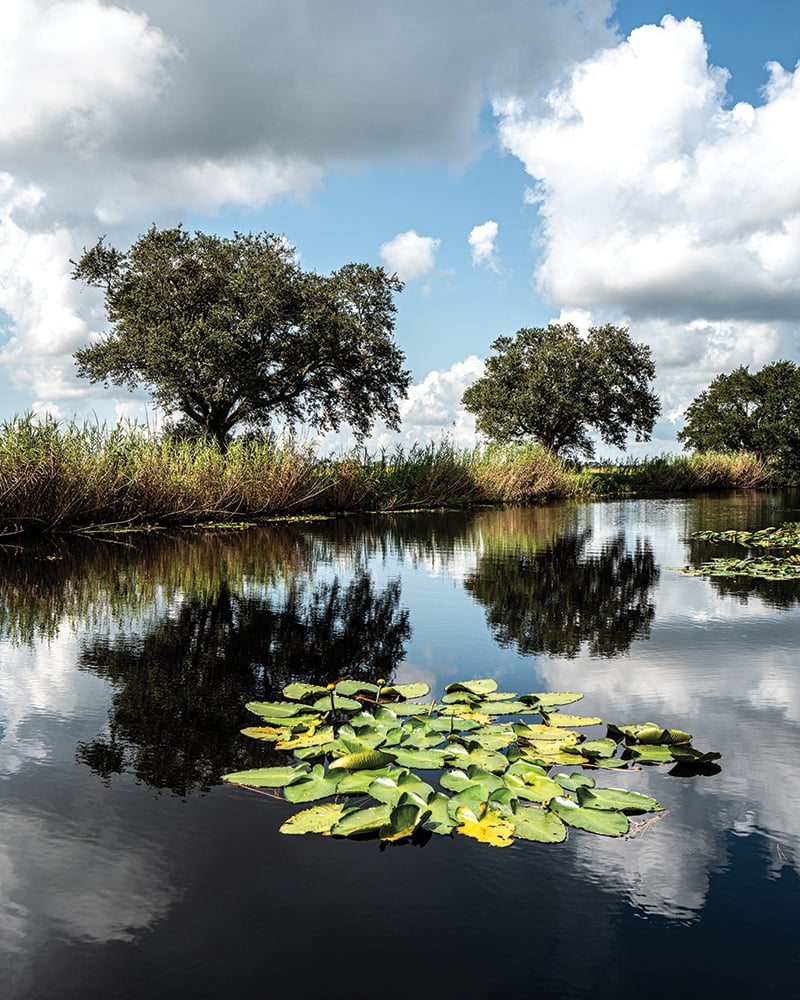The Wonders of White Lake Wetlands Conservation Area

“The airboat is ready to go,” says Lance Ardoin, but before we step into the cauldron of a South Louisiana August morning, there’s something I need to understand. In his office south of Gueydan, a well-thumbed copy of Aldo Leopold’s “A Sand County Almanac” on the shelf behind him, Ardoin leans forward. “White Lake Wetlands Conservation Area is not just important for winter waterfowl in Louisiana,” he says. “This place has long been recognized as one of the most important winter waterfowl grounds in all of North America.”
Located in southwest Vermilion Parish, White Lake WCA contains 52,000 acres of freshwater marshes, lakes, canals and bayous, with an additional 20,000 acres that it leases as farmland. A 12-mile stretch of the Gulf Intracoastal Waterway runs near its northern border, the north shore of White Lake at its southern end. Lyndon B. Johnson hunted here twice during his presidency. Today, the public must enter lotteries to receive coveted hunting tours that run only in parts of the WCA and only on limited days during each season. Approximately 20,000 acres are set aside strictly for wildlife refuge.
BP donated this land to the state of Louisiana in 2002. While the oil company holds mineral rights in perpetuity, it’s here that Ardoin, biologist manager at White Lake WCA, and a team of six biologists and technicians work year-round to maintain a healthy habitat for shorebirds, alligators and waterfowl that includes pintail mallards, hooded mergansers and greater white-fronted geese.

“The ultimate value in these marshes is wildness,” Leopold writes in “A Sand County Almanac,” the first book that Ardoin read in Wildlife Management 101 at McNeese State University. But preserving wildness is merely one of the full-time jobs he oversees. He and the team also work year round to protect farmlands and communities to the north from flooding.
“To continue to manage this place means to be on the front lines,” Ardoin says. “That means that we’re constantly working on various projects, including prescribed burns, herbicide spraying and hydraulic management. All that work creates a more diverse environment and gives waterfowl a food source and area to rest.”
Take one of those projects on its own — hydraulic management, say — and a much larger team would have no trouble keeping busy throughout the year. That’s because the waterways within White Lake WCA vary in elevation. Two 48-inch pumps maintain waterflow between Cadeau (also called Carreau) and the Florence Canal. To get from one to the other requires the airboat to climb an eight-foot spoil bank. In Cadeau, Ardoin turns the boat in the opposite direction of the spoil bank to provide enough distance to gain the speed necessary to cross. Adjusting his earmuffs, he says, “This is an aggressive jump. You’re going to want to hold on.” Then it begins, the tornado-whir of the boat’s fan, the passage from water to land and, briefly, it seems, into air, five seconds in all, tame-to-thrilling on the rollercoaster scale, and then we’re on the other side, swerving through a body of water three feet higher than the one we just left behind.

The first split in the conservation area provides boat access to north and south trails, providing navigation throughout the hunting marsh area.
Upkeep of spoil levees such as this one has been piecemeal over the years and requires monthly inspections. “When you’re talking about this amount of water,” Ardoin says, “a leak that starts as a rat hole quickly becomes a man-size hole.” Spoil banks also erode. Those along the Gulf Intracoastal Waterway deteriorate from storms and barge traffic. Since its construction a century ago, the waterway has also widened 100 feet. For nearby farmers, it’s essential that Ardoin and his team tame it.
Pulling up to a recently rebuilt section, we watch as waves from a passing barge rise halfway up the nearly four-foot spoil bank. “You can imagine what happens when a storm comes through,” he says. “This is just a Band-Aid. You need rocks to protect it.” Rock levees serve multiple purposes. Besides offering stronger protection, they also create marshland. As of now, only one and a half miles of rocks protect the northern border, but state funding has been approved for a partnership between White Lake WCA and the Coastal Protection and Restoration Authority to begin building more next year.

Constructed in November 2024, the Guillotine gate water control structure allows boats to pass allows boats to pass in and out of the hunting marsh while maintaining water levels in the 16,000-acre management unit.
“Our main hope is to protect the community,” Ardoin says, echoing Leopold’s aspiration: “When we see land as a community to which we belong,” he writes, “we may begin to use it with love and respect.” This, in every aspect, is Ardoin’s backyard. Turning the airboat around, he sets off to see what he needs to do next.
Parish
Vermilion
Did You Know?
• White Lake Wetlands Conservation Area includes a two-mile birding and nature trail that is open to the public year-round. Parking is available at the trailhead at the south end of Highway 91, 7.4 miles south of Gueydan. The trail area includes a covered pavilion with tables, two educational kiosks with information about species in the area and an observation tower at the trail’s southeast corner.
• A 500-acre island within White Lake WCA includes several buildings that can house a dozen hunters. Lyndon B. Johonson stayed here on the two occasions he hunted at White Lake during his presidency. A portrait of Johnson hangs in the Presidential Suite inside the largest of the buildings.
